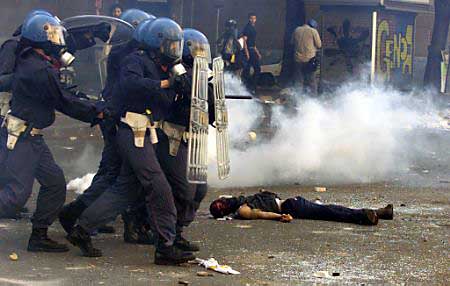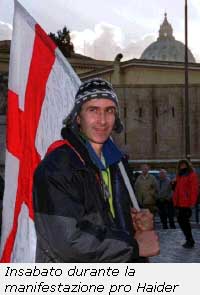
June 2002
Fascism,
Bonapartism and Police Terror in Italy

Carlo Giuliani, executed by cops in
Genova, 20 July 2001. (Photo:
Reuters)
In Genova, Italy last summer the government of Silvio Berlusconi imposed a veritable police state on tens of thousands of demonstrators protesting against the meetings of the heads of state of the eight leading capitalist powers (the Group of 8). On July 20, carabinieri (paramilitary national police) charged into a peaceful demonstration and as protesters scattered, they shot an “anti-globalization” demonstrator, Carlo Giuliani, in the head, rolled over him twice with a jeep and drove away. It was an execution. That night squads of riot police broke into the Diaz school which housed many protesters and the independent media center that was sending out news of the demonstrations. The blood-stained walls recorded the horrors that took place as scores of youth were brutally clubbed and hauled off to holding pens. As they were carrying out the attack, the cops repeatedly shouted “Viva Il Duce!” (Mussolini) and “Viva Pinochet!”
Italy is the West European country where the connection between fascists, police-state terror and a drive toward a bonapartist “strong state” stands out in sharpest relief. This is no accident, because for decades Italy simultaneously had the most solidly implanted fascist party and the largest Communist Party. The Movimento Sociale Italiano (MSI), which regularly got 5 percent of the vote, was founded in 1946 by the remnants of the Salò Republic, the last redoubt of Benito Mussolini at the end of World War II. In 1993 the MSI renamed itself the Alleanza Nazionale (AN) under the leadership of Gianfranco Fini, who declared the new party to be “post-fascist.” Yet despite the superficial face-lift and a split two years later of a tiny group nostalgic for the old days, the AN is essentially the same party as its fascist predecessor.
 Fascist
Alleanza Nazionale is the continuation of the fascist MSI.
Fascist
Alleanza Nazionale is the continuation of the fascist MSI.
In 1994, the AN got over 13 percent of the vote, and joined the government of rightist media magnate Silvio Berlusconi with five ministers. (In Naples, the niece of the Duce, Alessandra Mussolini, got almost 47 percent.) However, a series of massive workers strikes and judicial investigations of government corruption and conflicts of interest stymied the first Berlusconi government. The “Ulivo” (Olive Tree) popular front led by the social-democratic rump of the old Communist Party, the Democratic Left (DS), was elected two years later and, dependent on the parliamentary support of Rifondazione Comunista, it proceeded to push through many of the anti-worker “reforms” that the right-wing Berlusconi couldn’t get passed. As the working class became demoralized, Berlusconi’s Forza Italia won elections in March 2001 in alliance with Fini’s AN and Umberto Bossi’s Lega Nord, a right-wing populist regional party.
The AN was given the ministry of the interior, in charge of the numerous police forces. The fascist minister, Claudio Scajola, immediately began setting up special squads armed and trained for civil war. The carabinieri who shot Carlo Giuliani were brought up from the south, after being trained by Los Angeles sheriffs in military tactics used to suppress the 1992 L.A. upheaval. Hundreds of arrested protesters were sent to a prison camp outside Genova where they were tortured by the GOM prison riot cops, notorious for their fascist leanings and for carrying out massacres of inmates at Sassari and Secondigliano. Prisoners who refused to sing the fascist anthem Falcenetta were beaten. On the day of the attack, fascist vice-premier Fini himself was in the Genova police headquarters following the situation.
This is not to say that the bourgeois “democrats” and reformists aren’t capable of unleashing police terror – on the contrary. The plans for the Genova summit were begun under the previous popular-front government, and only a few weeks earlier the police of social-democratic Sweden gunned down an anti-globalization protester in Göteborg. As corporate mergers set off a new wave of layoffs and union gains are under attack throughout Europe, social-democratic and liberal parties are enacting draconian laws against immigrants and criminalizing leftist and labor demonstrations. In Italy, il cavaliere Berlusconi is an aspiring Bonaparte rather than a fascist; he was a member of the infamous P2 network whose influence extended throughout the political, military/police and business hierarchies. But while Berlusconi holds the baton, in a country like Italy – where ties between fascists and the secret services go back decades (the head of P2, Licio Gelli, was Mussolini’s envoy to Göring’s SS) and played a key role in the government’s “strategy of tension,” such as in the 1980 bombing of the Bologna train station that killed 85 – the heirs of Mussolini in the government play a key role in implementing police-state measures.
As Fini’s Alleanza Nazionale was preparing to enter the government last year, the Italian section of the International Communist League, the Lega Trotskista (LTd’I), declared that the AN “historical descendents” of the fascist MSI were “essentially an electoral phenomenon, no different from the Austrian FPÖ of Jörg Haider.” Certainly, “terrorist groups nostalgic for Mussolini commit frequent acts of fascist terror and violence, in the first place against immigrants and other minorities, the weakest strata of the proletariat,” they allowed, “but they are still far from having the strength to directly attack the organized workers movement” (Spartaco, April 2001). So because the terror is directed mainly at immigrants and other minorities, AN isn’t fascist according to the LTd’I! This is not only an astounding chauvinist statement but a falsehood as well. In fact the fascists’ victims aren’t only immigrants, as was dramatically shown in Genova only a few weeks later.
 Andrea
Insabato, who bombed leftist newspaper Il Manifesto in December 2000, shown
a week earlier at fascist demo greeting Jörg Haider in Rome. (Photo:
La Repubblica)
Andrea
Insabato, who bombed leftist newspaper Il Manifesto in December 2000, shown
a week earlier at fascist demo greeting Jörg Haider in Rome. (Photo:
La Repubblica)
But not only in Genova, and not only by fascist-infested police. In December 2000 one Andrea Insabato exploded a bomb at the offices of the leftist daily Il Manifesto in the center of Rome. The bomber was formerly close to the fascist terror group Forza Nuova and recently the anti-Semitic Militia of Christ; in the 1970s he had participated in an armed assault on a Communist Party office. Insabato was a regular at rallies of Fini’s Alleanza Nazionale, and the week before planting the bomb he was photographed at a fascist demonstration greeting Haider during a visit to Italy (see photo). That provocation was opposed by a mobilization of several thousand leftists shouting at Haider “fascist” and “Nazi raus” (Nazi get out). But for the LTd’I, the AN and Haider’s supporters are not fascists but only “electoralists” (with bombs?)
Police-state repression, and the role of the fascist AN in carrying it out, did not end with the uproar over the bloody cop terror in Genova. On May 31, the police raided two dozen homes of militants of union militants of the Cobas/SLAI syndicalist organization. The accusation: membership in an organization with subversive aims (Article 270), and offense to a public official (Article 342), for chanting “carabinieri – police – assassins”). Immigrants are particularly targeted with the passage on June 4 of a racist immigration law. Immigrant workers play an increasingly important role in Italian industry, notably in steel, and they have mobilized and even struck against the attacks on them. But they must not stand alone.
The Italian workers movement has to power to crush the fascists, but it is paralyzed by the reformist union and party bureaucrats, in particular by Rifondazione Comunista, who bind it to bourgeois “allies.” Last fall, teachers and others struck against Italy’s participation in the war on Afghanistan and the attacks on labor at home. In February, March and April of this year there were escalating protests demonstrations against the Berlusconi government culminating in an April 16 general strike that brought out 13 million Italian workers and 3 million demonstrators against the government’s anti-labor reforms. But this tremendous power and energy was dissipated by the reformist union and party leaders who are trying to breathe some life into the moribund Ulivo popular front. The key to defeating the drive for a “strong state” whose central purpose is to break the power of the Italian workers movement, is to build a genuinely Trotskyist vanguard which can tell a fascist party when it sees it, recognizes the danger of bonapartism and knows how to defeat it – through international socialist revolution.
Go to: National
Front at Forefront of Capitalist Drive Toward “Strong State” in France(8
June 2002)
How
ICL Turns French Fascists Into Ballot-Box Rightists (8
June 2002)
France:
Popular Front Paves the Way for Fascist Reaction (26
April 2002)
To contact the Internationalist Group and the League for the Fourth International, send e-mail to: internationalistgroup@msn.com